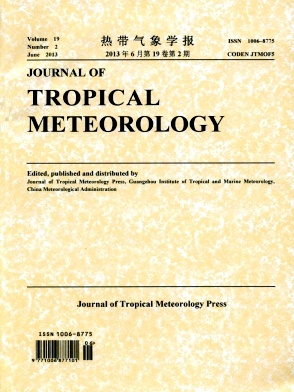|
[1]
|
IPCC. Climate Change 2001: The Scientific Basis [M].Cambridge: Cambridge University Press, 2001: 148-149. |
|
[2]
|
CHEN Hong-bin. On the anomalous absorption of solarradiation by water clouds and by the cloudy atmosphere [J]. Sci.Atmos. Sinica, 1997, 21(6): 750-757(in Chinese). |
|
[3]
|
FORSTER P, RAMASWAMY V, ARTAXO P, et al.Observations: surface and atmospheric climate change [C]//SOLOMON S, QIN D, MANNING M, et al. (eds). ClimateChange 2007: The Physical Science Basis. Contributions ofworking group I to the fourth assessment report of theIntergovernmental Panel on Climate Change. Cambridge:Cambridge University Press, 2007: 275-277. |
|
[4]
|
HENDERSON-SELLERS A. Continental cloudinesschanges this century [J]. J. Geophys. Res., 1992, 27: 255-262. |
|
[5]
|
KARL T R, STEURER P M. Increased cloudiness in theUnited States during the first half of the twentieth century: Factor fiction? [J]. Geophys. Res. Lett., 1990, 17: 1925-1928. |
|
[6]
|
SUN B, GROISMAN P Y. Cloudiness variations over theformer Soviet Union [J]. J. Geophys. Res., 2000, 20:1097-1111. |
|
[7]
|
NEFF W D. Decadal time scale trends and variability in thetropospheric circulation over the South Pole [J]. J. Geophys.Res., 1999, 104: 27217-27251. |
|
[8]
|
KAISER D P. Analysis of total cloud amount over China,1951-1994 [J]. J. Geophys. Res., 1998, 25: 3599-3602. |
|
[9]
|
KAISER D P. Decreasing cloudiness over China: Anupdated analysis examining additional variables [J]. J. Geophys.Res., 2000, 27: 2193-2196. |
|
[10]
|
MAUGERI M, BAGNATI Z, BRUNETTI M, et al. Trendsin Italian total cloud amount 1951―1996 [J]. J. Geophys. Res.,2001, 28: 4551-4554. |
|
[11]
|
AUEL I, BOHM R, JURKOVIC A, et al.HISTALP-Historical instrumental climatological surface timeseries of the greater Alpine region [J]. Int. J. Climatol., 2007,27: 17-46. |
|
[12]
|
LIU Hong-li, ZHU Wen-qin, YI Shu-hua, et al. Climaticanalysis of the cloud over China [J]. Acta Meteor. Sinica, 2003,61(4): 466-473(in Chinese). |
|
[13]
|
WEI Li, ZHONG Qiang. Characteristics of cloudclimatology over Qinghai-Xizang plateau [J]. Plateau Meteor.,1997, 16(1): 10-15(in Chinese). |
|
[14]
|
CHEN Shao-yong, DONG An-xiang, WANG Li-ping.Climate change features of total cloud cover over NorthwestChina [J]. J. Chengdu Univ. Inf. Technol., 2006, 21(3):423-428(in Chinese). |
|
[15]
|
DING Shou-guo, SHI Guang-yu, ZHAO Chun-sheng.Analyze the change of global different cloud cover and thelikely impact on climate in nearly 20 years by the use of ISCCPD2 material [J]. Chin. Sci. Bull., 2004, 49(11): 1105-1111(inChinese). |
|
[16]
|
ROSSOW W B, SCHIFFER R A. Advances inunderstanding clouds from ISCCP [J]. Bull. Amer. Meteor. Soc.,1999, 80(11): 2261-2288. |
|
[17]
|
ROSSOW W B, SCHIFFER R A. ISCCP cloud dataproducts [J]. Bull. Amer. Meteor. Soc., 1991, 72(1): 2-20. |
|
[18]
|
ROSSOW W B, GARDER L C. Validation of ISCCPcloud detections [J]. J. Climate, 1993, 6(12): 2370-2393. |
|
[19]
|
ROSSOW W B, WALKER A W, GARDER L C.Comparison of ISCCP and other cloud amounts [J]. J. Climate,1993, 6: 2394-2418. |
|
[20]
|
HAHN C J, ROSSOW W B, WARREN S G. ISCCP cloudproperties associated with standard cloud types identified inindividual surface observations [J]. J. Climate, 2001, 14: 11-28. |
|
[21]
|
WEI Li, ZHONG Qiang, HOU Ping. Evaluation on cloudvariables from ISCCP data over Chinese continent [J]. PlateauMeteor., 1996, 15(2): 147-156(in Chinese). |
|
[22]
|
WENG Du-ming, HAN Ai-mei. Comparison between totalcloudiness from satellite cloud pictures and groundobservations over China [J]. Quart. J. Appl. Meteor., 1998, 9(1):32-37(in Chinese). |
|
[23]
|
WANG Ke-li, JIANG Hao, CHEN Shi-qiang, et al. Cloudcover over Qinghai-Xizang Plateau: Comparison amongMeteorological Station observations, ISCCP-C2, and NCEPReanalysis Data [J]. Plateau Meteor., 2001, 20(3): 1-7(inChinese). |
|
[24]
|
HUANG Jia-you. Statistical analysis and forecastingmethods in meteorology (third edition) [M]. Beijing: ChinaMeteorological Press, 2004(in Chinese). |
|
[25]
|
WEI Feng-ying. Modern diagnostic and statistical weatherprediction techniques (second edition) [M]. Beijing: ChinaMeteorological Press, 2007(in Chinese). |
|
[26]
|
KANG In-Sik, HO Chang-Hoi, LIM Young-Kwon.Principal modes of climatological seasonal and intraseasonalvariations of the Asian summer monsoon [J]. Mon. Wea. Rev.,1999, 127: 322-340. |
|
[27]
|
EVAN A T, HEIDINGER A K, VIMONT D J. Argumentsagainst a physical long-term trend in global ISCCP cloudamounts [J]. Geophys. Res. Lett., 2007, 34: 701-705. |

















 粤公网安备 4401069904700002号
粤公网安备 4401069904700002号
 DownLoad:
DownLoad: